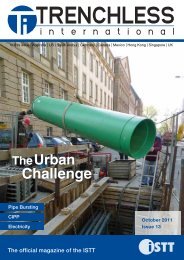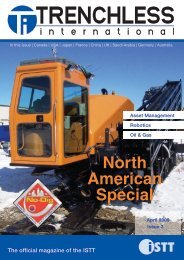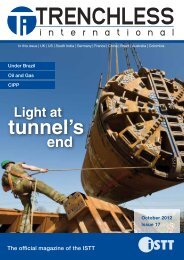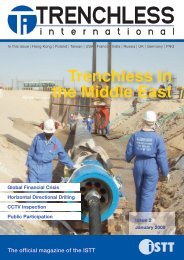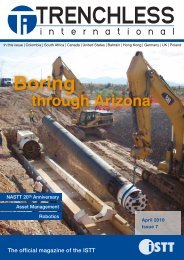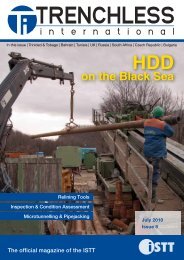Singapore - Trenchless International
Singapore - Trenchless International
Singapore - Trenchless International
You also want an ePaper? Increase the reach of your titles
YUMPU automatically turns print PDFs into web optimized ePapers that Google loves.
PROjeCts<br />
October 2010 - <strong>Trenchless</strong> <strong>International</strong><br />
36<br />
The Robbins Double Shield Rockhead is steered continuously from an in-shield operator’s console.<br />
The Robbins Rockhead is excavating the first<br />
900 m with a mixed ground cutterhead for<br />
soft shale and limestone, before switching to<br />
a hard rock cutterhead.<br />
the seven tunnels, with their varying<br />
grades, result in a change of<br />
54 vertical metres over the course of the<br />
project. As a result of the elevation change,<br />
the tunnels travel through different strata<br />
consisting of softer shale and limestone for<br />
the first 900 m, changing to harder, drier<br />
shale and limestone for the later tunnels.<br />
to effectively excavate in the conditions,<br />
Midwest Mole needed a solution to excavate<br />
mixed ground as well as hard rock up to<br />
165 MPa UCs.<br />
“the Rockhead was the best suited to the<br />
project conditions based on our previous<br />
experience with similar Robbins machines.<br />
two-pass tunnelling with a Double shield<br />
Rockhead was also more cost effective<br />
than microtunnelling when we prepared our<br />
estimates,” said Mr Abernathy.<br />
the original contract allowed for either<br />
microtunnelling or two-pass tunnelling,<br />
which allows for installation of a primary<br />
liner before placing the carrier pipe.<br />
the Double shield Rockhead was<br />
designed with a mixed ground cutterhead<br />
that can be changed out for a hard rock<br />
cutterhead later on. the mixed ground cutterhead<br />
features 6.5 inch single disc cutters<br />
and carbide bits, combined with large<br />
openings in the cutterhead to ingest mixed<br />
ground and to allow for cutter changes.<br />
the hard rock cutterhead is dressed<br />
with 11.5 inch diameter single disc cutters<br />
and abrasion-resistant muck scrapers, as<br />
well as a cutterhead opening for cutter<br />
changes. Crews will switch out the cutterhead<br />
between crossings in one of the<br />
launch/receiving shafts.<br />
how it works<br />
the Robbins Double shield Rockhead<br />
(sBU-RHDs) is a tunnelling machine for use<br />
on longer utility installations, usually over<br />
180 m, in unstable ground. It is also typically<br />
used for line and grade-critical installations<br />
such as gravity sewers, as the machine can<br />
be continuously steered from an in-shield<br />
operator’s console. Line and grade are<br />
monitored continuously using a laser targeting<br />
system.<br />
the machine, available in diameters from<br />
1.3 to 2 m, consists of a circular cutterhead<br />
optimised for either mixed ground or hard<br />
rock. Hard rock disc cutters are capable of<br />
excavating ground ranging from 25 to over<br />
175 MPa UCs.<br />
As the cutterhead rotates, disc cutters<br />
penetrate the rock face and create a ‘crush<br />
zone’ through which fractures propagate.<br />
Material between adjacent crush zones is<br />
then chipped from the rock face.<br />
Muck scrapers scoop the muck into<br />
openings on the cutterhead called muck<br />
buckets, which transfer the material to a<br />
machine belt conveyor. Muck removal from<br />
the site is by either a belt conveyor or<br />
muck cars.<br />
crossing excavation<br />
Excavation of the first tunnel began on<br />
19 May 2010, from an 11 m deep shaft.<br />
the Robbins Rockhead completed its first<br />
474 m long drive in three months, holing<br />
through on 18 August into a shaft site.<br />
“the mixed ground cutterhead is ideal for<br />
the ground. After 474 m there is almost no<br />
perceptible wear of the teeth or disc cutters.<br />
the machine also drives very smoothly and<br />
has plenty of power for these conditions,”<br />
said Mr Abernathy.<br />
Crews reported advance rates averaging<br />
150 mm per minute in low strength<br />
shale using the mixed ground cutterhead.<br />
Advance rates topped out at 32 m in<br />
24 hours, or 21 1.5 m long ring beam and<br />
board sets in two ten-hour shifts. the swift<br />
advance comes despite some unforeseen<br />
difficulties, including a section directly below<br />
the creek bed with significant groundwater,<br />
and gripper slippage in the soft, wet ground<br />
during machine pushes.<br />
the machine was launched from its<br />
receiving shaft to bore a second 575 m<br />
long tunnel on 30 August, following some<br />
maintenance and modifications. Changes<br />
included modifying the hydraulic system<br />
for increased gripper and roll correction<br />
cylinder pressure. the increases allowed<br />
the machine to grip and roll correct in the<br />
extremely soft, often wet rock.<br />
As the machine bores, a primary liner of<br />
ring beams and lagging is set every 1.5 m.<br />
After each ring is built, a muck train consisting<br />
of a battery-operated locomotive and<br />
three muck cars removes spoils from the<br />
tunnel. the muck will be used as back-fill<br />
around some of the shaft sites after project<br />
completion, and potentially as fill on private<br />
property in the area.<br />
Work on the launch/receiving shafts is<br />
ongoing – four shafts are now complete<br />
using a combination of drill and blast techniques<br />
and manual excavation. some open<br />
cut pipe jacking operations are also connecting<br />
existing, peripheral lines to the new<br />
sewer line.<br />
Midwest Mole recently utilised a<br />
760 mm diameter Robbins sBU-A for a<br />
46 m long crossing of the creek, which will<br />
connect a 460 mm diameter PVC sewer to<br />
the main line.<br />
the work to date has been successful,<br />
in large part due to teamwork between<br />
Midwest Mole, Robbins field service, and<br />
the project owner.<br />
“If there is one thing we would like to<br />
emphasise, it would be how willing the contractor<br />
has been to work with us throughout<br />
the project. In addition to proposing the<br />
tunnelling method, they planned value<br />
engineering that resulted in substantial<br />
cost savings,” said Mr Bloom.<br />
“When the project was bid, there were<br />
originally eleven shafts, but Midwest Mole<br />
proposed to eliminate three shafts. they<br />
obtained easement rights to alter the project<br />
alignment, and shortened the project schedule<br />
with their new plan.”<br />
All seven of the tunnels and the eight<br />
manhole shafts are expected to be completed<br />
by May 2012.<br />
Primary Program (Jan. 25-27)<br />
I Introduction to Sewer & Water Rehab Technologies<br />
II Sewer Construction, Rehabilitation & New Technology<br />
III Cured-in-Place Pipe<br />
IV Pipe Bursting: View from the Field<br />
V WaterWorks Conference: Facing Reality<br />
VI Storm Water<br />
VII <strong>Trenchless</strong> Technical Symposium<br />
VIII HDD: Rigonomics & Operations<br />
IX Alternative Energy Construction<br />
X Damage Prevention & Safety Conference<br />
XI Underground Utilities Construction<br />
CEUs and PDHs available!<br />
AKKERMAN<br />
Reduced<br />
Registration<br />
Rates In<br />
Effect!






